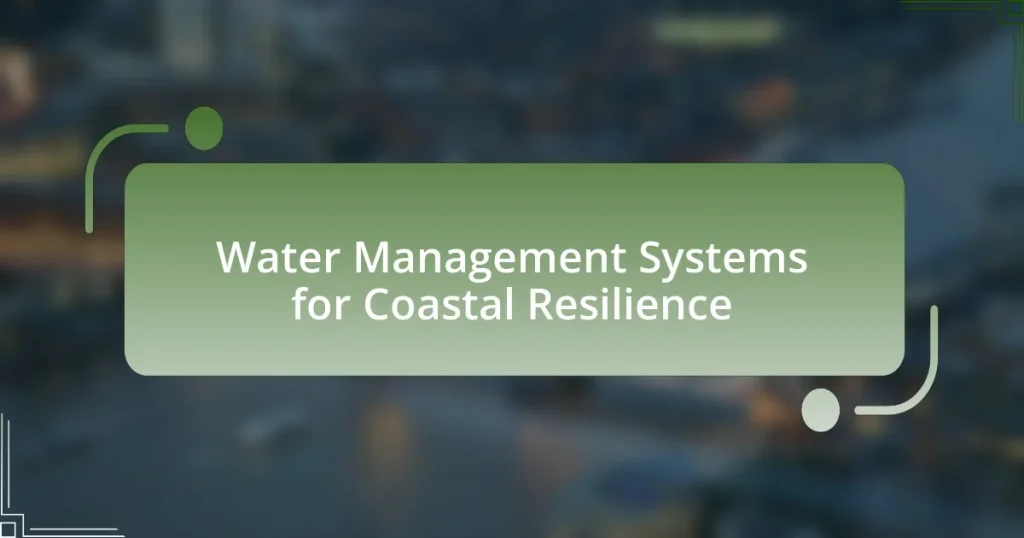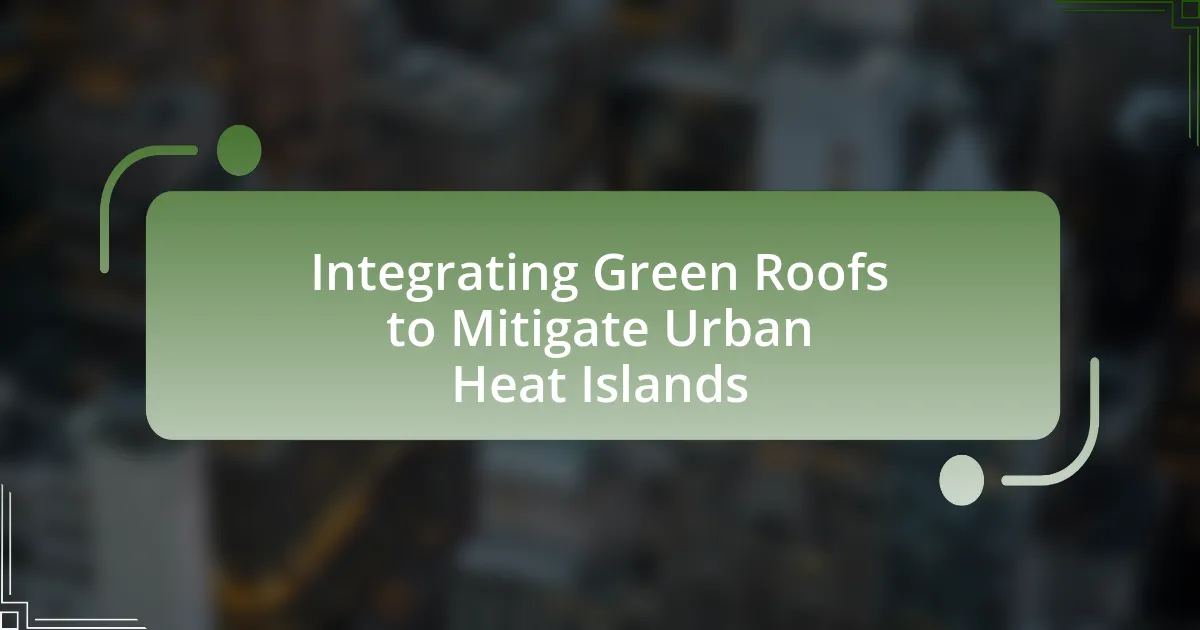Water Management Systems for Coastal Resilience are integrated frameworks aimed at effectively managing water resources in coastal areas to enhance their ability to withstand climate-related impacts such as flooding and sea-level rise. These systems combine natural infrastructure, like wetlands and mangroves, with engineered solutions, including levees and seawalls, and sustainable water use policies. Key components include water supply, quality management, drainage systems, flood control, and wastewater treatment, all working together to mitigate risks and promote resilience. The article also explores the importance of coastal resilience in the context of climate change, the challenges faced by coastal areas, and the role of technology and community engagement in implementing effective water management strategies.
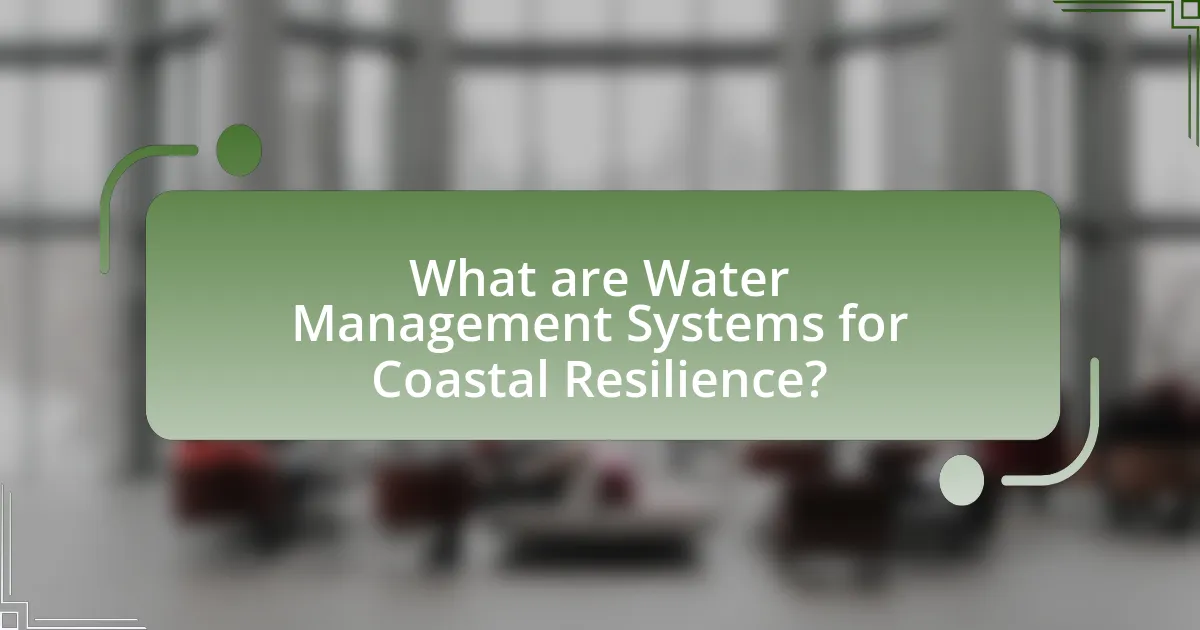
What are Water Management Systems for Coastal Resilience?
Water Management Systems for Coastal Resilience are integrated frameworks designed to manage water resources effectively in coastal areas, enhancing their ability to withstand and recover from climate-related impacts such as flooding and sea-level rise. These systems incorporate various strategies, including the use of natural infrastructure like wetlands and mangroves, engineered solutions like levees and seawalls, and policies for sustainable water use and conservation. Research indicates that such systems can significantly reduce vulnerability to extreme weather events, as evidenced by studies showing that coastal wetlands can lower flood risks by absorbing storm surges and reducing wave energy.
How do Water Management Systems contribute to coastal resilience?
Water Management Systems enhance coastal resilience by effectively managing water flow and mitigating flood risks. These systems include infrastructure such as levees, drainage systems, and wetlands that absorb excess water during storms, reducing the impact of flooding on coastal communities. For instance, the integration of green infrastructure, like restored wetlands, can decrease storm surge impacts by up to 50%, as evidenced by studies conducted in coastal regions like Louisiana. Additionally, these systems facilitate the sustainable use of water resources, ensuring that ecosystems remain healthy and can adapt to changing climate conditions, further supporting coastal resilience.
What are the key components of Water Management Systems?
The key components of Water Management Systems include water supply, water quality management, drainage systems, flood control, and wastewater treatment. Water supply ensures the availability of fresh water for various uses, while water quality management focuses on maintaining the safety and cleanliness of water resources. Drainage systems are designed to manage surface water runoff, preventing flooding and erosion. Flood control mechanisms, such as levees and floodgates, protect areas from inundation during extreme weather events. Wastewater treatment processes are essential for recycling water and reducing pollution, thereby safeguarding public health and the environment. These components work together to enhance coastal resilience by effectively managing water resources in vulnerable areas.
How do these components interact to enhance coastal resilience?
Water management systems enhance coastal resilience by integrating natural and engineered components to mitigate flooding, erosion, and habitat loss. These systems, such as wetlands, dunes, and seawalls, work together to absorb storm surges, filter pollutants, and provide critical habitats for wildlife. For instance, wetlands can reduce wave energy and trap sediments, while seawalls protect infrastructure from direct wave impact. Studies show that areas with robust water management systems experience significantly less damage during extreme weather events, demonstrating their effectiveness in enhancing coastal resilience.
Why is coastal resilience important in today’s context?
Coastal resilience is crucial in today’s context due to the increasing threats posed by climate change, such as rising sea levels and more frequent extreme weather events. These factors endanger coastal communities, ecosystems, and economies, necessitating robust strategies to mitigate risks and adapt to changing conditions. For instance, according to the National Oceanic and Atmospheric Administration (NOAA), sea levels are projected to rise by 1 to 8 feet by 2100, significantly impacting coastal infrastructure and habitats. Effective water management systems enhance coastal resilience by improving flood protection, preserving natural buffers like wetlands, and ensuring sustainable resource management, thereby safeguarding both human and ecological health.
What challenges do coastal areas face that necessitate resilience?
Coastal areas face significant challenges such as rising sea levels, increased storm intensity, and coastal erosion, which necessitate resilience. Rising sea levels, projected to increase by up to 1 meter by 2100, threaten infrastructure and ecosystems, while more intense storms lead to flooding and damage to coastal communities. Additionally, coastal erosion, exacerbated by human activities and climate change, results in the loss of land and habitats. These factors collectively underscore the urgent need for adaptive water management systems to enhance resilience in coastal regions.
How does climate change impact coastal resilience?
Climate change significantly impacts coastal resilience by increasing the frequency and intensity of extreme weather events, such as hurricanes and flooding. These changes lead to greater erosion, habitat loss, and damage to infrastructure along coastlines. For instance, a study by the National Oceanic and Atmospheric Administration (NOAA) indicates that sea levels have risen by approximately 8 inches since 1880, exacerbating flooding risks in coastal areas. Additionally, warmer ocean temperatures contribute to stronger storms, which can overwhelm existing water management systems and reduce their effectiveness in protecting coastal communities.
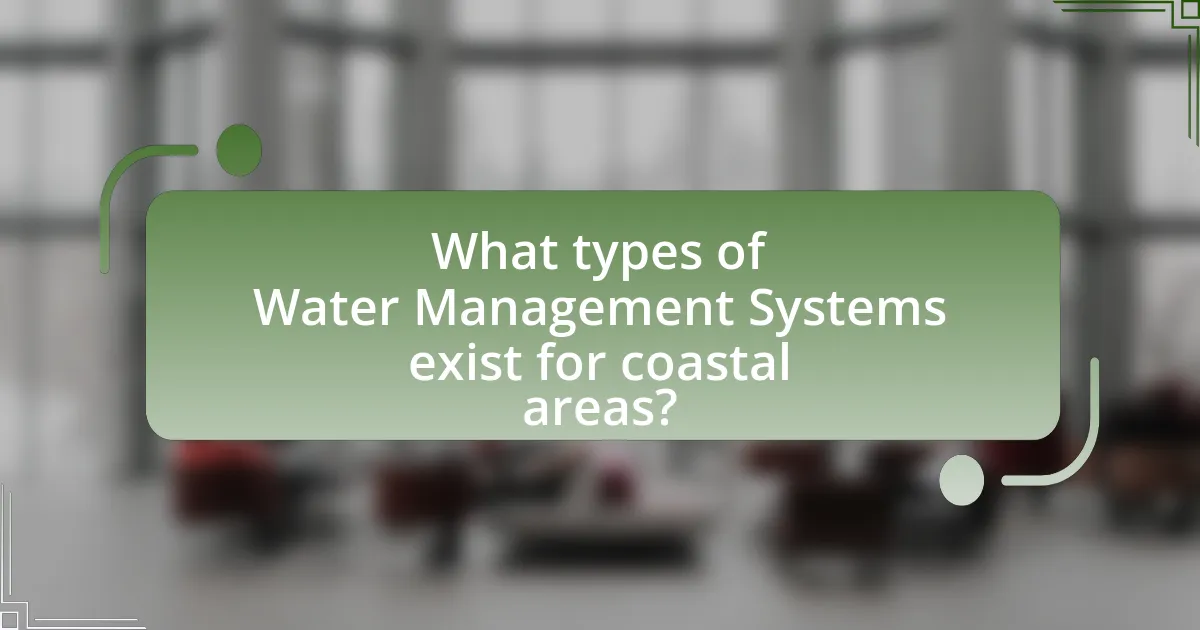
What types of Water Management Systems exist for coastal areas?
There are several types of water management systems for coastal areas, including integrated coastal zone management (ICZM), stormwater management systems, and flood control systems. Integrated coastal zone management focuses on the sustainable development of coastal resources while balancing environmental, economic, and social objectives. Stormwater management systems are designed to control runoff and reduce flooding, often incorporating green infrastructure such as bioswales and permeable pavements. Flood control systems, including levees and seawalls, are constructed to protect coastal communities from storm surges and rising sea levels. These systems are essential for enhancing coastal resilience against climate change impacts and extreme weather events.
How do traditional systems differ from modern approaches?
Traditional water management systems typically rely on historical practices and local knowledge, focusing on community-based approaches and natural water cycles. In contrast, modern approaches utilize advanced technology, data analytics, and integrated management strategies to address complex challenges such as climate change and urbanization. For example, traditional systems may involve simple irrigation techniques and local water conservation methods, while modern systems incorporate smart sensors, real-time monitoring, and predictive modeling to optimize water use and enhance resilience against flooding and drought. This shift reflects a broader trend towards sustainability and efficiency in managing water resources, supported by innovations in engineering and environmental science.
What are the advantages of integrated water management systems?
Integrated water management systems offer several advantages, including improved resource efficiency, enhanced water quality, and increased resilience to climate change. These systems facilitate the coordinated development and management of water, land, and related resources, which leads to optimized water use and reduced waste. For instance, studies have shown that integrated approaches can reduce water consumption by up to 30% in agricultural settings, thereby conserving vital resources. Additionally, these systems promote better water quality through the implementation of sustainable practices, which can decrease pollution levels in water bodies. Furthermore, integrated water management enhances resilience by enabling communities to adapt to changing climate conditions, as evidenced by successful case studies in coastal regions where such systems have mitigated flooding and erosion risks.
How do nature-based solutions fit into water management?
Nature-based solutions integrate natural processes into water management to enhance resilience against flooding, improve water quality, and restore ecosystems. These solutions, such as wetland restoration and green infrastructure, mimic natural hydrological cycles, allowing for better stormwater management and reducing the impact of extreme weather events. For instance, the restoration of coastal wetlands can absorb storm surges, protecting inland areas from flooding while also providing habitat for wildlife. Studies have shown that implementing nature-based solutions can reduce flood risks by up to 30% in vulnerable coastal regions, demonstrating their effectiveness in water management systems aimed at coastal resilience.
What role do technology and innovation play in these systems?
Technology and innovation are crucial in enhancing water management systems for coastal resilience by improving efficiency, accuracy, and adaptability. Advanced technologies such as remote sensing, geographic information systems (GIS), and data analytics enable real-time monitoring of water quality and quantity, allowing for timely decision-making. For instance, the integration of smart sensors in water management systems can provide precise data on flood levels, which is essential for effective flood management and mitigation strategies. Furthermore, innovative approaches like green infrastructure and nature-based solutions, such as restoring wetlands, have been shown to enhance coastal resilience by providing natural barriers against storm surges and erosion. These advancements not only optimize resource use but also promote sustainable practices, ultimately leading to more resilient coastal communities.
How can data analytics improve water management strategies?
Data analytics can significantly enhance water management strategies by enabling precise monitoring, forecasting, and decision-making. By analyzing historical and real-time data, water managers can identify patterns in water usage, predict demand fluctuations, and optimize resource allocation. For instance, a study by the World Resources Institute found that data-driven approaches can reduce water losses by up to 30% in urban areas, demonstrating the effectiveness of analytics in improving efficiency. Additionally, predictive analytics can help in anticipating flooding events, allowing for timely interventions that protect coastal communities. This integration of data analytics into water management not only improves operational efficiency but also supports sustainable practices in the face of climate change.
What emerging technologies are shaping coastal water management?
Emerging technologies shaping coastal water management include remote sensing, artificial intelligence, and blockchain. Remote sensing technologies, such as satellite imagery and drones, enable real-time monitoring of coastal ecosystems, allowing for better assessment of water quality and habitat changes. Artificial intelligence enhances data analysis and predictive modeling, facilitating informed decision-making for resource allocation and disaster response. Blockchain technology provides transparent and secure data sharing among stakeholders, improving collaboration and trust in water management practices. These technologies collectively contribute to more effective and resilient coastal water management strategies.
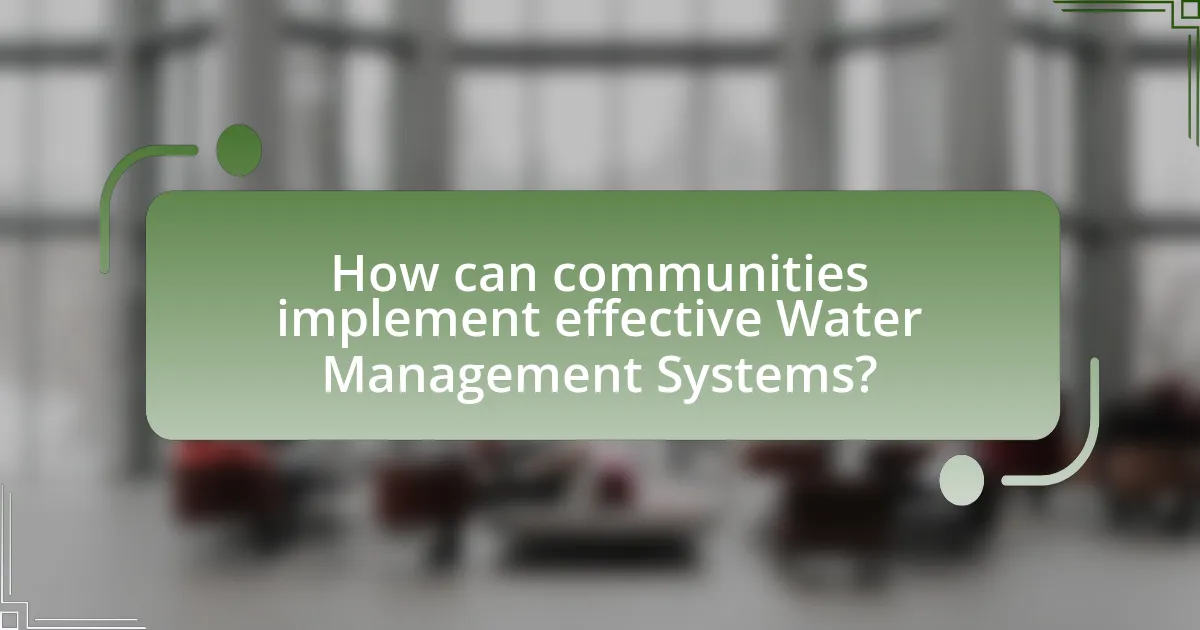
How can communities implement effective Water Management Systems?
Communities can implement effective Water Management Systems by adopting integrated approaches that combine sustainable practices, technology, and community engagement. For instance, utilizing rainwater harvesting and wastewater recycling can significantly reduce reliance on freshwater sources, as demonstrated by the success of such systems in cities like Cape Town, which has improved water security through innovative management strategies. Additionally, employing smart water management technologies, such as sensors and data analytics, allows for real-time monitoring and efficient distribution of water resources, as evidenced by the implementation of smart meters in various urban areas that have led to a reduction in water loss by up to 30%. Engaging local stakeholders in decision-making processes ensures that the systems are tailored to community needs, fostering a sense of ownership and responsibility, which has been shown to enhance the effectiveness of water management initiatives in regions like the Netherlands, where community involvement has been pivotal in flood management strategies.
What best practices should communities follow for implementation?
Communities should adopt an integrated approach to water management systems for coastal resilience, focusing on collaboration, stakeholder engagement, and adaptive management. This involves involving local stakeholders in the planning process to ensure that diverse perspectives are considered, which enhances community buy-in and effectiveness. Additionally, implementing nature-based solutions, such as restoring wetlands and mangroves, has been shown to provide effective flood protection and improve water quality, as evidenced by studies indicating that coastal ecosystems can reduce storm surge impacts by up to 50%. Regular monitoring and evaluation of water management practices are essential to adapt strategies based on changing environmental conditions and community needs, ensuring long-term resilience.
How can stakeholder engagement enhance system effectiveness?
Stakeholder engagement enhances system effectiveness by fostering collaboration and ensuring that diverse perspectives are integrated into decision-making processes. This collaborative approach leads to more informed and sustainable solutions, as stakeholders often possess valuable local knowledge and insights that can improve system design and implementation. For instance, research indicates that involving local communities in water management decisions can lead to a 30% increase in project success rates, as these stakeholders are more likely to support initiatives that reflect their needs and priorities. Engaging stakeholders also promotes transparency and accountability, which can enhance trust and cooperation among all parties involved, ultimately leading to more resilient water management systems in coastal areas.
What are the common pitfalls to avoid in system implementation?
Common pitfalls to avoid in system implementation include inadequate stakeholder engagement, insufficient training, and lack of clear objectives. Inadequate stakeholder engagement can lead to resistance and misalignment with user needs, as seen in various projects where user feedback was overlooked, resulting in low adoption rates. Insufficient training can hinder effective use of the system, as evidenced by studies showing that organizations with comprehensive training programs experience higher success rates. Lastly, a lack of clear objectives can cause scope creep and misallocation of resources, which has been documented in project management literature as a leading cause of project failure.
What resources are available for communities seeking to improve their systems?
Communities seeking to improve their water management systems for coastal resilience can access various resources, including federal grants, technical assistance programs, and community engagement tools. The U.S. Environmental Protection Agency (EPA) offers funding opportunities through programs like the Clean Water State Revolving Fund, which supports projects aimed at improving water quality and infrastructure. Additionally, organizations such as the National Oceanic and Atmospheric Administration (NOAA) provide technical assistance and guidance on best practices for coastal management. Community engagement resources, such as the Community-Based Social Marketing approach, help involve local stakeholders in decision-making processes, ensuring that improvements are tailored to specific community needs. These resources collectively enhance the capacity of communities to develop effective and sustainable water management systems.
How can local governments support water management initiatives?
Local governments can support water management initiatives by implementing policies that promote sustainable water use and investing in infrastructure improvements. For instance, they can establish regulations that encourage water conservation practices among residents and businesses, which can lead to a measurable reduction in water consumption. Additionally, local governments can allocate funding for the development of green infrastructure, such as rain gardens and permeable pavements, which enhance stormwater management and reduce flooding risks. Evidence from the U.S. Environmental Protection Agency indicates that green infrastructure can reduce runoff by 30-50%, demonstrating its effectiveness in managing water resources. By fostering community engagement and collaboration with stakeholders, local governments can also enhance public awareness and participation in water management efforts, further strengthening the resilience of coastal areas.
What funding opportunities exist for coastal resilience projects?
Funding opportunities for coastal resilience projects include federal grants, state programs, and private foundations. The National Oceanic and Atmospheric Administration (NOAA) offers the Coastal Zone Management Program, which provides funding for projects that enhance coastal resilience. Additionally, the Federal Emergency Management Agency (FEMA) has the Hazard Mitigation Grant Program, which supports projects aimed at reducing disaster risk in coastal areas. State-level initiatives, such as the California Coastal Conservancy, also allocate funds for local resilience projects. Furthermore, organizations like the Nature Conservancy and the Surdna Foundation provide grants specifically for environmental resilience efforts. These funding sources are critical for implementing effective water management systems that enhance coastal resilience.
What practical steps can communities take to enhance their water management systems?
Communities can enhance their water management systems by implementing integrated water resource management (IWRM) practices. IWRM promotes the coordinated development and management of water, land, and related resources to maximize economic and social welfare without compromising the sustainability of vital ecosystems. For example, the United Nations emphasizes that IWRM can lead to improved water quality, increased water availability, and enhanced resilience to climate change impacts. Additionally, communities can invest in green infrastructure, such as rain gardens and permeable pavements, which help manage stormwater and reduce flooding risks. Research from the Environmental Protection Agency shows that green infrastructure can reduce runoff by 30-50%, thereby improving water quality and availability. Furthermore, engaging local stakeholders in decision-making processes ensures that water management strategies are tailored to community needs and environmental conditions, fostering a sense of ownership and responsibility.
